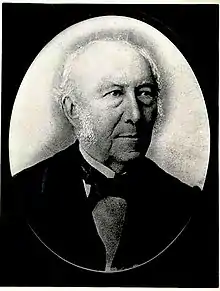Daniel Gowland
Daniel Gowland (1798–1883) was a British merchant and banker,[1] who served as member of the board of directors of the Argentine Western Railway.[2] He had an active participation in the commerce of Buenos Aires, toward 1856 he introduced from England La Porteña, the first locomotive train of the Argentina.[3]
Daniel Gowland Phillips | |
|---|---|
 | |
| Director of Bank of the Provincias Unidas del Río de la Plata | |
| In office 1833–1834 | |
| Personal details | |
| Born | Daniel James Gowland Phillips February 8, 1798 London, United Kingdom |
| Died | March 8, 1883 Buenos Aires, Argentina |
| Resting place | La Recoleta Cemetery |
| Nationality | |
| Occupation | merchant importer exporter |
| Profession | financier |
| Signature | |
Biography
He was born in Camberwell (London), son of Thomas Gowland and Sarah Philips, belonging to a high class family. He had arrived at the port of Buenos Aires with his parents and brothers in 1812.[4] In 1826, Gowland was married in the Anglican Cathedral of St. John the Baptist of Buenos Aires to María del Rosario Rubio de Velasco, daughter of José Rubio de Velasco, born in Cádiz, and Juana María Ribero Kelly, a Creole lady, belonging to a family of Irish roots.[5]
Established in Buenos Aires, he had founded the family business Gowland & Co.[6] A large exporting and importing company, integrated among other by his brother Thomas Gowland Phillips.[7] He was closely associated with the first railroad constructions in Argentina, being vice-president of Argentine Great Western Railway.[8] He was appointed president of the Commission of British Merchants in Buenos Aires in 1853,[9] and also served as commercial agent of the government of the Argentine Confederation in Buenos Aires.[10]
He also had an active participation in the banking institutions of Argentina, serving as executive director of the Bank of the Province of Buenos Aires between 1833 and 1834.[11]
His granddaughter, Sara Gowland Freyer, was married to Juan Alberto Lacroze Cernadas,[12] relative of Federico Lacroze, owner of Buenos Aires Central Railway.[13]
References
- Informal Empire in Latin America: Culture, Commerce, and Capital. Matthew Brown. 20 April 2009. ISBN 9781444306620.
- British-Owned Railways in Argentina: Their Effect on the Growth of Economic. Winthrop R. Wright. September 2014. ISBN 9780292772977.
- El Club de residentes extranjeros: breve resena historica en homeaje a sus fundadores. Jorge Navarro Viola. 1941.
- El Club de residentes extranjeros. Coni, 1941. 1941.
- Sí, quiero: historias y anécdotas del matrimonio en la Argentina, siglos XVI a XIX. Arnoldo Canclini. 2005. ISBN 9789500427333.
- The Monthly Law Reporter, Volume 20. Stephen Henry Phillips. 1858.
- Summa: revista de arquitectura, tecnología y diseño, Issues 281–286. Ediciones Summa SACIFI, 1991.
- Arquitectura ferroviaria. Jorge Tartarini.
- La Guerra del Paraguay: estado, política y negocios. León Pomer.
- El País de los argentinos. Centro Editor de América Latina. 1979.
- Censo nacional de población y vivienda, 1991. Instituto Nacional de Estadística y Censos (Argentina).
- Guía biográfica. Jacobo Peuser, 1904. 1904.
lacroze sara gowland.
- Manual informativo de la ciudad de Buenos Aires. Instituto Histórico de la Ciudad de Buenos Aires. 1981.